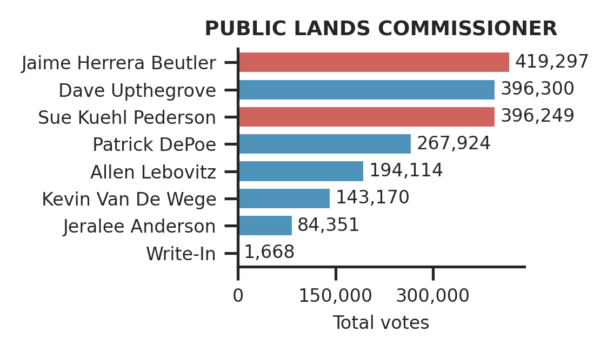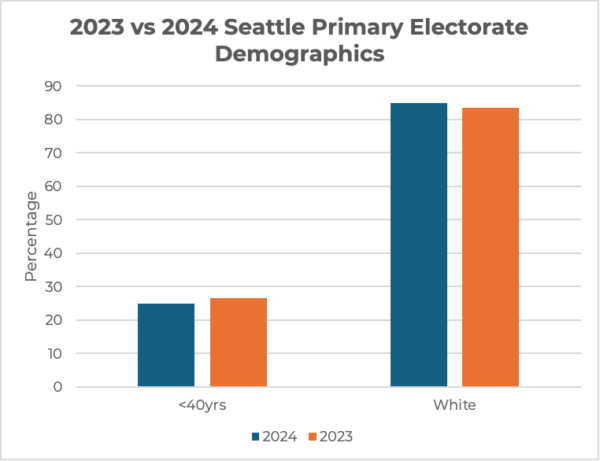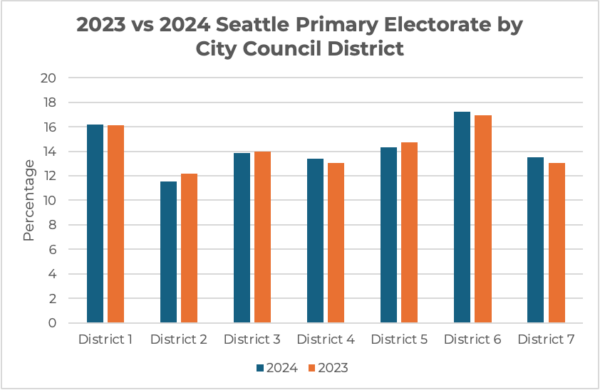
UPDATE: August 23, 2024
Public Lands Commissioner: Democrats: 57.4%, Republican: 42.6%
After weeks of counting ballots the final results for the Public Lands Commissioner are in: Democrat Dave Upthegrove will, for now, move on to the General Election by just 51 votes Statewide.
This narrow margin of <0.01% will trigger an automatic recount that could last for even more weeks. This isn’t the first time a statewide recount has occurred: Senator Maria Cantwell won her Senate seat by 2,229 votes after a recount, as did Governor Christine Gregoire by 130 votes in 2004. Upthegrove will hope Democrats’ streak continues with him in what will be the first statewide recount in a Primary Election in recent memory.
Despite Upthegrove just squeaking by, Democrats actually performed strong collectively winning 57-43 when you tally up votes by party. Washington’s Top Two Primary system and a (nearly) perfect Republican vote-split almost locked Democrats out of the General despite a strong majority of voters supporting Democrats.
In a standard partisan primary system, neither this (costly) recount nor pressure for candidates to drop out to prevent vote-splitting would have happened. Perhaps a system that can lock out a majority party from even contesting in the General Election isn’t a good system.
The First WA Primary Statewide Recount
There have been just three statewide recounts in Washington State since the year 2000. But, all three of those were between the years 2000-2004, which means it has been two full decades since we fired up the old statewide recount machine.
If you feel like this race and recount are getting a lot of attention on the interwebs, it is in part because statewide recounts are quite rare in the nation. Thanks to data compiled by FairVote, we know there have only been 36 statewide recounts in a General Election since the year 2000, approximately 1.5 per year or 1 per 192 election contests. Unfortunately data on Primary Election recounts is not readily available, but we could not track down any record of a Washington Primary going to a statewide recount since the top-two format was adopted in 2008. So, this is a first.
Of those 36 statewide General Election recounts, only three resulted in the outcome changing from the initially certified results. But, one of those three was the 2004 Washington Governor contest when Christine Gregoire overtook Dino Rossi after a protracted 6 month recount effort and court battle which was not fully resolved until May 2005, some six months after the election was held. It is considered the closest gubernatorial race in our country’s history.
The Washington Land Commissioner contest will need to be resolved much quicker than the 2004 Governor contest because General Election ballots will start being mailed out to military and overseas voters in mid-September. Election managers need to get ballots printed ASAP and they need to know which candidates to include.
In fact, Washington moved its Primary from September to August because election managers were nervous that there wouldn’t be enough time to resolve a recount like the 2004 Governor contest if it had happened in the Primary instead of the General. In 2002, former Republican Secretary of State Sam Reed warned that it would be a “train wreck” if a primary contest required a statewide recount under the previous timeline. At that time, Washington had the shortest time between Primary and General Elections in the nation, at just seven weeks. Reed elaborated that he did not want a “Florida-type problem” in reference to the 2000 presidential election. So, he had been sounding the alarm that an adjustment to the Primary-General timeline was needed before the 2004 recount. It was pain of the long recount and legal battle that helped Reed get the timeline change across the finish line with the legislature. Hopefully those extra weeks will alleviate the long predicted time crunch that is now a reality.
Voter Turnout & Political Environment
The first ballots have been counted in WA’s (notably predictive) 2024 Primary elections. These initial Primary election results reflect only about two thirds of the final results we’ll see certified later this month, so expect changes in close races.
Historically, the late ballots skew slightly more Republican statewide, but it varies by county (late ballots in Seattle are famously more left-wing). We can expect results to shift as much as 7-10% after Tuesday night, so expect the unexpected. The final results were ~1-3% more Republican than the initial results in 2020.
When you aggregate every statewide race’s votes by party, Democrats are leading 57-41% (D+16) after Tuesday. In 2020 when all votes were tabulated, that breakdown was 49-38% (D+11)—roughly D+13 after Night 1. If 2020 trends hold, we can expect about a D+14 final statewide result—3% bluer than 2020.
| 2020 General | 2020-24 Primary Shift | 2024 General (Projected) | |
| WA Avg. Env. | D+19 | D+3 | D+22 |
| President (national popular vote) | D+4.5 | D+7.5 | |
| President (Electoral Votes) | 306 | 319 | |
| WA Governor | D+13.5 | D+16.5 | |
| WA-08 | D+4 | D+7 | |
| WA-03* | D+1 | D+2 | D+3 |
*WA-03 data uses 2022 data instead of 2020. This is also reflected in a D+2 2022-2024 primary environment shift
If WA trends spill over nationally, the Primary results thus far suggests a 3% bluer national environment in November than 2020. This would’ve flipped North Carolina’s 15 electoral votes for Democrat Joe Biden in 2020—an optimistic sign for Vice President Kamala Harris.
Turnout is slightly down from 2020’s record-shattering Primary (54%), but on track for typical presidential year Primary elections (43%). We’re waiting to see another couple ballot drops before drawing definitive conclusions about turnout. Follow along with us with our Early Vote Dashboard.
Statewide Races
US Senate: Democrats: 58.3%, Republican: 38.9%
Democratic incumbent Maria Cantwell is ahead 58-21% in the Primary, running slightly ahead of her 55% in 2018, signaling a similarly blue political environment to 2018’s blue wave. She’s well on-track to win re-election in November.
Governor: Democrats: 54.9%, Republican: 43.3%
Similarly, Democratic Attorney General Bob Ferguson is leading Republican ex-Congressman Dave Reichert 45-28%.
Public Lands Commissioner: Democrats: 57.1%, Republican: 42.9%
One of the nail-biters is the open race for Public Lands Commissioner, where Republicans Jaime Herrera Beutler and Sue Kuehl Pederson lead 5 Democrats. Leading Democrat and King County Councilmember Dave Upthegrove trails Pederson by ~10,000 votes (20.7-19.9%) with hundreds of thousands of ballots left to count—get comfy.
Attorney General: Democrats: 56.7%, Republican: 43.3%
Democrat Nick Brown defeated Democratic State Senator Manka Dhingra for 2nd place in the Attorney General race. Brown will likely beat Republican Pete Serrano in the General, who received less than 44% compared to Democrats’ collective 57%.
US House: Key Races
On average since 2012, Republicans have outpaced their Primary performance by 3-4% in the General Election.
3rd CD: Democrats: 46.0%, Republicans: 51.6%
The hottest race was in the 3rd CD. Democrats got a welcome result with extremist Republican Joe Kent beating establishment-backed Leslie Lewallen. Democratic incumbent Marie Gluesenkamp Perez got 46% vs Republican’s collective 51%. It’s hard to tell how this will shake out in November as Perez (the sole Democrat) only got 31% in 2022’s Primary because many Democratic voters voted for moderate Republican Jaime Herrera Beutler to stop extremist Kent, but Perez wound up winning in November by courting enough Buetler voters and boosting turnout against Kent’s extremism. Perez’s chances rely on doing the same in 2024.
4th CD: Democrats: 23.7%, Republicans 74.9%,
Pro-Impeachment Republicans (Newhouse): 24.5%, Other Republicans: 50.4%
Several Republicans challenged one of last sitting Republicans who voted to impeach Donald Trump after January 6, 2021’s insurrection, Dan Newhouse. Newhouse sits in second ahead of Republican Tiffany Smiley 24-19% and behind Republican Jerrod Sessler 31-24%. If Newhouse advances to the General (a likely event), he’ll need all of the Democrats’ 24% vote share to beat the anti-Newhouse Republican collective 50% in the Primary.
5th CD: Democrats: 40.5%, Republicans: 59.4%
Democrats avoided disaster with Democrat Carmela Conroy winning 2nd by 20-12%. Republican Michael Baumgartner won with 28% to advance to the General with Conroy. Dems need a miracle to win here, like what Dems achieved in the 3rd CD two years ago.
6th CD: Democrats: 59.3%, Republicans: 37.8%
Democratic State Sen. Emily Randall leads Democratic Public Lands Commissioner 34-25% to join (current) 2nd place finisher Republican Drew MacEwen (30%). This marks an impressive grassroots victory for Randall after an establishment push for Franz after Rep. Derek Kilmer retired unexpectedly last year.
8th CD: Democrats: 55.3%, Republicans: 44.6%
Democratic incumbent Kim Schrier leads Republican Carmen Goers 51-44% in what’s materializing as her easiest election yet. This is the highest Democratic percentage in the Primary since Dems flipped the 8th in 2018.
State Legislature Composition
Democrats come into this year’s elections holding a 9 seat advantage in the Washington Senate and a 18 seat advantage in the Washington House. Only a handful of legislative districts were competitive enough in the Primary to suggest that there will be any change to the Democrats advantage. Primary results have estimated the General election with an average error of just 2%. As of Wednesday, only two contests were within a 2% margin: 17th LD Senate and 25th LD House Position 1. We will also be watching contests in the 10th and 14th as additional ballots are tabulated.
Here is our State Legislature composition based on historic patterns of Primary-to-General election shifts:
| 2022 | 2024 (Projected) | |
| Senate | 29-20 Democrats | 29-20 Democrats |
| House | 58-40 Democrats | 58-40 Democrats |
14th Leg. District
We’re most keyed into the 14th LD, which spans Latino communities in South Central WA (Yakima, Pasco). While this newly-drawn Biden district is leaning about 60-40 for Republicans currently, this isn’t over for Democrats because the Primary and General electorates look very different in this district: BIPOC comprised 30% of 2020 Primary ballots compared to 47% of 2020 General ballots. Indeed, statewide Democrats gained 10-15% between the 2020 Primary and General, suggesting Democrats can still win in November as long as they stay around 40% in the Primary.
We think Dems will increase their margins with late ballots. Updated ballot return data and historical trends show late ballots remain in more Democratic areas—indeed Wednesday’s new counts in Yakima County showed a bump for Dems. Our eyes will stay glued on the 14th as we expect the numbers to change dramatically later this week and in November.
| 14th LD Primary to General Democratic Vote Share | |||
| 2020 Primary | 2020 General | 2020 Primary to General Shift | |
| Governor | 39.70% | 55.00% | +15.30% |
| AG | 44.90% | 57.30% | +12.40% |
| Treasurer | 42.60% | 54.70% | +12.10% |
| Average | 42.40% | 55.70% | +13.30% |
Seattle City Council
Progressive Alexis Mercedes Rinck leads moderate appointed-Councilmember Tanya Woo 47-41% in this year’s special Seattle city council election—a lead that will likely expand with late ballots. These results are more progressive than city council primaries last year in 2023 and 2021.
One may intuitively credit the high-turnout, even-year election for this progressive bump. Indeed more Seattleites have already voted in 2024’s Primary than last year’s 2023 Primary—with many more ballots left uncounted. In fact, nearly ⅓ (~50,000 voters and growing) of Seattle 2024 Primary voters did not vote in 2023’s Primary.
However, while there are more voters in 2024, they look pretty similar to 2023’s primary electorate. 2024 was only about 2% more BIPOC and young (<40yrs). They came from roughly the same places (city council districts), too. These statistics may shift slightly in the coming days as late (younger, less white) ballots are counted.
So Seattle progressives’ victory is not obviously because of the even-year environment, but because progressives have flipped a sizable number of voters.
Another example of a strong night for Seattle progressives is Democratic Socialist Shaun Scott’s bid for state house in the 43rd LD. After losing a city council race in 2019, his 55-23% lead suggests 2024 is a good year for Seattle lefties.
–
This Post is a project of the Washington Community Alliance Action Fund and our contributors. For those seeking more information and real-time election results, the Washington Community Alliance Data Hub is our data-driven resource hub providing accessible research and responsive technical assistance to promote high-participation elections. You can find daily election results posted on our Primary Elections Dashboard. Also stay tuned for the comprehensive Data Hub Primary Election Report which will be posted after election certification at the end of August.
Contributors:
Andrew Hong, Washington Community Alliance Action Fund
Kamau Chege, Washington Community Alliance Action Fund
Logan Camporeale, Campo Consulting





